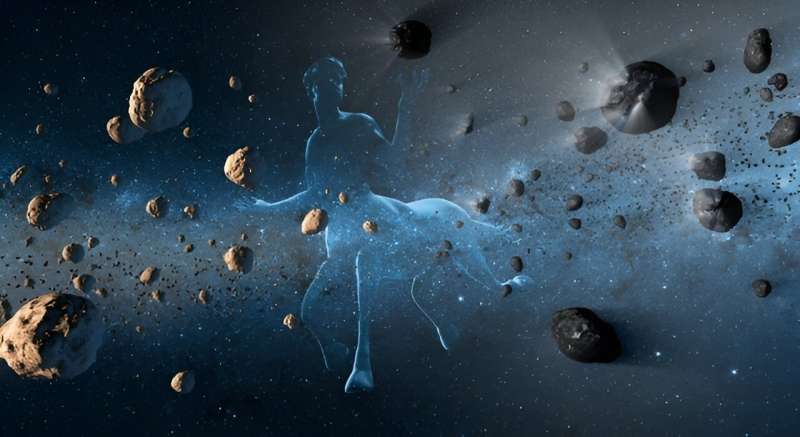This article has been reviewed according to Science X's editorial process and policies. Editors have highlighted the following attributes while ensuring the content's credibility:
fact-checked
peer-reviewed publication
trusted source
proofread
JWST detects carbon dioxide in a centaur for the first time

A study published Nov. 6 in The Planetary Science Journal examines how NASA's James Webb Space Telescope (JWST) has conducted a first-time detection of carbon dioxide in a centaur, this one designated 39P/Oterma. A centaur is a small planetary body that orbits between Jupiter and Neptune and frequently crosses the orbits of one or more of the gas giant planets within our solar system.
While no centaur has been imaged up-close, they typically exhibit a combination of attributes between comets and asteroids. While carbon monoxide has been detected in two known centaurs, this recent discovery could mark a turning point in how scientists understand the formation, evolution, and composition of not only centaurs, but of the early solar system, as well.
"Centaurs are important to study since they are fairly well-preserved objects in space that can provide insight on the chemical composition and physical processes of the early solar system," study lead author, Dr. Olga Harrington Pinto, who is a postdoctoral researcher at Auburn University but conducted the research while a Ph.D. student at the University of Central Florida, tells Universe Today.
Centaur 39P/Oterma was discovered on April 8, 1943, by Finnish astronomer, Dr. Liisi Oterma, who was the first woman to earn Ph.D. in astronomy in Finland, along with being the first woman Ph.D. of the faculty of sciences at Turku University. While 39P/Oterma has long been classified as an inactive comet, it currently exhibits a centaur-like orbit between Jupiter and Saturn, meaning it doesn't approach the sun, and has a radius of approximately 2.21 to 2.49 km (1.37 to 1.55 mi), according to this study. So, why was 39P/Oterma chosen for this specific study?
"39P/Oterma is what we call an active centaur, a centaur that develops a coma and a tail like a normal comet," Dr. Adam McKay, who is an assistant professor in the Department of Physics and Astronomy at Appalachian State University and a co-author on the study, tells Universe Today. "Since they are active, we can use spectroscopy to observe molecules in their coma to gain insights into their composition. 39P was chosen as one of our targets because it would be active during the time of the proposed observations."
For the study, the researchers used JWST's Near-Infrared Spectrograph (NIRSpec) instrument and was supported by ground-based observations from the Gemini North Observatory and Lowell Discovery Telescope to investigate the characteristics of 39P/Oterma while it was orbiting close to its perihelion (closest distance to the sun) at 5.82 astronomical units (AU) from the sun in July 2022. For context, the perihelion of 39P/Oterma has gradually increased since its discovery: 3.39 AU (1958), 5.47 AU (1983), and 5.71 AU (2023), and is projected to reach 5.91 AU and 6.15 AU in 2042 and 2246, respectively.
After analyzing the JWST NIRSpec data, the researchers confirmed the first detection of carbon dioxide in any centaur, and the lowest amount of carbon dioxide ever detected in any centaur or comet. They also did not detect traces of water or carbon monoxide, which are traditionally detected in centaurs, specifically 29P/Schwassmann-Wachmann 1 (29P/SW1), another centaur that shares approximately the same AU distance as 39P/Oterma.
"These results are important because they show that thanks to the impressive capabilities of JWST, we are able to see low production rates of a relatively small object that is very far away," Dr. Pinto tells Universe Today. "And, though the production rates are low, it shows a different chemical behavior from another centaur, 29P/SW1, seen at a similar distance (~6 AU). This difference in chemical behavior could be from the very different sizes of centaurs 29P and 39P, or from having different orbital histories, or starting out with different compositions, or possibly a combination of all of these."
The finding of carbon dioxide in a centaur could be a gamechanger in terms of understanding the compositions and characteristics of centaurs, asteroids, and comets throughout the solar system, along with potentially gaining better insight into the formation and evolution of the solar system, overall.
More information: O. Harrington Pinto et al, First Detection of CO2 Emission in a Centaur: JWST NIRSpec Observations of 39P/Oterma, The Planetary Science Journal (2023). DOI: 10.3847/PSJ/acf928
Journal information: The Planetary Science Journal
Provided by Universe Today





















